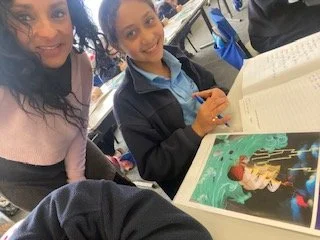
Think Forward Blog
5 Memes to Help Teachers Support Improved Student Behaviour at School
There has been a lot of recent commentary about student behaviour in schools and what teachers should do about it. We thought it might be useful to share a series of five “memes” over the coming days that may enhance a teacher’s ability to understand and implement evidence-based behaviour support practices in their classroom. Each meme is based on a significant body of research evidence and may be used to add depth or breadth to practices that you are familiar with already (such as explicit instruction and opportunities to respond).
Guest blog: What happens when we correlate NAPLAN data with Comparative Judgement?
Comparative Judgement is an innovative new assessment that has recently become available in Australia. Traditional marking, including NAPLAN Writing, involves the use of a rubric. Comparative Judgement relies on many educators comparing one script to another until a continuum of scripts is formed. To understand if Comparative Judgement can be a useful predictor for national writing assessment, No More Marking are able to make some interesting correlations.
Looking back on Think Forward - A message from the founder
A message from Think Forward Educators founder Dr Nathaniel Swain
Introducing The New CEO - Katie
Introducing Katie Roberts-Hull, the new Think Forward Educators CEO
Why do students write the way they speak?
An overarching problem encountered in many classrooms is having our students write the way they speak. Why do they do this?
Language acquisition is a biologically primary skill, meaning humans will naturally learn how to speak. However, the written word is a skill that must be taught.
Five Ways To Use Self-Explanation Prompts
Following on from last year’s successful series of blog articles on 5 ways to implement the science of reading, this year experts will be providing ready-to-use tips on the science of maths.
Inspired by Tom Sherrington’s Five Ways Collection, the posts have been edited and curated by Brendan Lee and Dr Nathaniel Swain.
The first blog post of the series comes from maths guru, Alex Blanksby.
Five Ways To Start Teaching Fractions
Following on from last year’s successful series of blog articles on 5 ways to implement the science of reading, this year experts will be providing ready-to-use tips on the science of maths.
Inspired by Tom Sherrington’s Five Ways Collection, the posts have been edited and curated by Brendan Lee and Dr Nathaniel Swain.
The second blog post of the series comes from maths guru, Karen Tzanetopoulos.
Five Ways to use Worked Examples
Following on from last year’s successful series of blog articles on 5 ways to implement the science of reading, this year experts will be providing ready-to-use tips on the science of maths.
Inspired by Tom Sherrington’s Five Ways Collection, the posts have been edited and curated by Brendan Lee and Dr Nathaniel Swain.
The first blog post of the series comes from maths guru, Alex Blanksby.
Writing Assessment is Hard! How should we report assessments to parents?
What is the best way of reporting assessment information to students & parents? This is a question I hear all the time, and it isn’t easy to answer. What we all want is an assessment system that is (a) accurate, (b) easy to understand, (c) not too time-consuming for staff, and (d) motivating for students. But these principles are all in conflict with each other.
5 Ways To Engage Leaders In The Science Of Learning
This article from Brendan Lee looks at what we can do to support school leaders in implementing the science of learning.
Mark DLD Day with Free Resources
So what is Developmental Language Disorder (DLD)? According to data from the SCALES Project, led by Professor Courtney Norbury, it affects 1 in 14 children, which equates to approximately 2 children in every classroom. Each person’s language profile will look different but common features include difficulties with:
Learning and using new words, Word finding, Understanding and using complex sentences, Understanding the nuances of conversation, Working memory, Reading. Chances are that someone in your everyday life has this hidden condition. Please take the time to learn a little more. It could make all the difference.
5 Ways To: Support Oral Language
Think Forward Educators is posting a series of blog articles written by educational experts providing ready-to-use tips on how to implement the Science of Reading into the classroom. Inspired by Tom Sherrington’s Five Ways Collection, the posts have been edited and curated by Brendan Lee and Dr Nathaniel Swain. This blog post on Oral Language comes from teacher and speech-language pathologist, Kathryn Thorburn.
5 Ways to: Focus on Fluency
Over the coming weeks, Think Forward Educators will be posting a series of blog articles written by educational experts providing ready-to-use tips on how to implement the Science of Reading into the classroom. Inspired by Tom Sherrington’s Five Ways Collection, the posts have been edited and curated by Brendan Lee and Dr Nathaniel Swain. The fourth blog post of the series from teacher and learning specialist, James Dobson gives us a comprehensive look at fluency.
5 Ways to: Improve Comprehension Instruction
Over the coming weeks, Think Forward Educators will be posting a series of blog articles written by educational experts providing ready-to-use tips on how to implement the Science of Reading into the classroom. Inspired by Tom Sherrington’s Five Ways Collection, the posts have been edited and curated by Brendan Lee and Dr Nathaniel Swain. This third post of the series comes from teacher and consultant, Debbie Draper, on the teaching of comprehension.
5 Ways To: Be Strategic In Your Phonics Instruction
Over the coming weeks, Think Forward Educators will be posting a series of blog articles written by educational experts providing ready-to-use tips on how to implement the Science of Reading into the classroom. Inspired by Tom Sherrington’s Five Ways Collection, the posts have been edited and curated by Brendan Lee and Dr Nathaniel Swain. The second blog post of the series comes from teacher and consultant, Lindsey Bartes, on Phonics teaching.
The difference between a sentence that’s well-written and a sentence that’s, well, written.
Do you accept that correct sentence structure is the building block of quality writing? Then you possibly have entered into a journey with grammar that feels like a road map of rules, terms, symbols and arrangements that are blasting cognitive load. While we know to teach grammar in context, we have to also understand that parts of grammar are sequential. We advocate for taking the time in your writing scope and sequence to focus on small aspects of grammar, cement it in working memory, practice it, retrieve it and then drop in opportunities for reference or application among all the other moments when students are writing. Read more and come along to writing network discussion!
The empowering legacy of Linnea Ehri
When we say we are following the Science of Reading, few of us are really following the original research, but rather the curricula and programs chosen by our school leaders. Unfortunately, the translation of research into practice is a hazardous route, and one that practitioners should navigate using our own in-depth knowledge of the research. Linnea Ehri is an American educational psychologist and expert on the development of reading who has empowered us teachers of reading. Her legacy of theory and research has given us remarkably accessible insight into how we learn to read. Her insights reflect a deceptively simple, but very powerful, theory of the development of our mental ‘lexicon’, and should form the working models of all reading teachers.
5 Ways To: Improve Phonological Awareness
Over the coming weeks, Think Forward Educators will be posting a series of blog articles written by educational experts providing ready-to-use tips on how to implement the Science of Reading into the classroom. Inspired by Tom Sherrington’s Five Ways Collection, the posts have been edited and curated by Brendan Lee and Dr Nathaniel Swain. The first blog post of the series comes from structured literacy specialist, Jocelyn Seamer. Phonological and phonemic awareness (PA) are the bridge between oral language and decoding (Kilpatrick, 2015).
How Non-Volunteers Reveal Everything by Dr Deslea Konza
Students who are paying attention are, by definition, on task, and more likely to attract teacher praise. This is why as teachers we find ourselves calling upon those with hands raised to get the lesson flowing smoothly. But if teachers only respond to volunteers, they are monitoring the understanding of about 20% of students, usually the higher-achievers. Randomisation ensures that the learning of a larger sample of students is being monitored. Sampling a larger proportion of students assesses the effectiveness of teaching much more accurately.
Five Ways Series: The Science of Reading
Five Ways Series: The Science of Reading
Over the coming weeks, Think Forward Educators will be posting a series of blog articles written by educational experts providing ready-to-use tips on how to implement the Science of Reading into the classroom.
Inspired by Tom Sherrington’s Five Ways Collection, the posts have been edited and curated by Brendan Lee and Dr Nathaniel Swain.





















Over the coming weeks, Think Forward Educators will be posting a series of blog articles written by educational experts providing ready-to-use tips on how to implement the Science of Reading into the classroom. Inspired by Tom Sherrington’s Five Ways Collection, the posts have been edited and curated by Brendan Lee and Dr Nathaniel Swain. The second blog post of the series comes from teacher and consultant, Lindsey Bartes, on Phonics teaching.